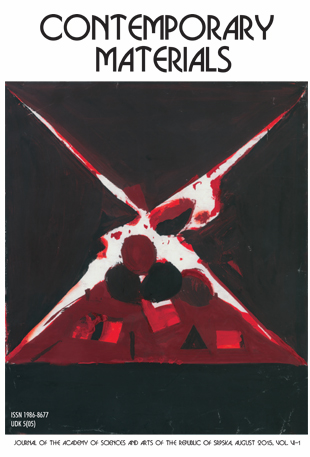NANO INSULATION MATERIALS FOR ENERGY EFFICIENT BUILDINGS
DOI:
https://doi.org/10.7251/COMEN1502149BAbstract
The advanced thermal insulation materials and solutions for improved thermal resistance have been receiving an ever increasing attention due to their significance for sustainable building. Reducing energy consumption and CO2 emissions by development and deployment of sustainable construction technologies, systems and materials in new and existing buildings will be key to addressing the challenge of a transition to nearly zero-energy buildings in Europe by 2020. Nanotechnology promises to make thermal insulation more efficient, less reliant on non-renewable resources as an important strategy on the pathway to green buildings. The application of nano insulation materials to limit the wall thickness is one of the greatest potential energy-saving characteristics for the existing buildings, as well as for the architectural heritage.
This paper examines the potential advantages of using nanotechnology-based high-performance thermal insulation materials in reducing the life cycle energy, reduction of material usage and enhancing the life span of buildings.
References
Energy Efficiency Plan 2011 [Online] Available at: http://ec.europa.eu/energy/efficiency/action_plan/action_plan_en.htm) [Accessed 10 February 2015].
Directive 2012/27/EU of the European Parliament and of the Council of 25 October 2012 on energy efficiency, amending Directives 2009/125/EC and 2010/30/EU and repealing Directives 2004/8/EC and 2006/32/EC. [Online] Available at: http://eurlex.europa.eu/LexUriServ/LexUriServ.do?uri=OJ:L:2012:315:0001:0056:EN:PDF) [Accessed 13 February 2015].
Directive 2002/91/EC of the European Parliament and of the Council of 16 December 2002 on the energy performance of buildings, Official Journal L 001, 04/01/2003 pp. 65-71. [Online] Available at: http://eur-lex.europa.eu/legal-content/EN/TXT/?uri=celex:32002L0091) [Accessed 13 February 2015].
Directive 2010/31/EU of the European Parliament and of the Council of 19 May 2010 on the energy performance of buildings, Official Journal L 153, 18/06/2010, pp 13-135. [Online] Available at: http://eur-lex.europa.eu/legal-con-tent/EN/TXT/PDF/?uri=CELEX:32010L0031&from=EN) [Accessed 13 February 2015].
U. Juschkus, Zwergenträume - Nanoschäume. Energieeffizientes Bauen mit Nanotechnologie, RKW-Fachinfo - Nanotechnologie am Bau 2010, 1, 7-9.
Available at: http://engineering.unt.edu/materials/mpsl/materials-synthesis-and-processing-laboratory-research [Accessed 11 May 2015].
Available at: http://energy.lbl.gov/ecs/aerogels/sa-pore.html [Accessed 21 May 2015].
E. Cuce, P. M. Cuce, C. Wood, S. Riffat, Toward aerogel based thermal superinsulation in buildings: A comprehensive review. Renew. Sustain. Energy Rev., Vol. 34 (2014) 273–299.
M. Koebel, A. Rigacci, P. Achard, Aerogel-based thermal superinsulation: An overview. J. Sol-Gel Sci. Technol., Vol. 63 (2012) 315–339.
C. Buratti, E. Moretti, Glazing systems with silica aerogel for energy savings in buildings, Appl. Energy, Vol. 98 (2012) 396–403.
R. Beatens, B. P. Jelle, A. Gustavsen, Aerogel insulation for building applications: A state-of-the-art review, Energy Build., Vol. 43 (2011) 761–769.
T. Gao, B. P. Jelle, T. Ihara, A. Gustavsen, Insulating glazing units with silica aerogel granules: The impact of particle size, Appl. Energy, Vol. 128 (2014) 27–34.
S. B. Riffat, G. Qiu, A review of state-of-the-art aerogel applications in buildings, Int. J. Low-Carbon Technol., Vol. 8 (2013) 1–6.
E. Wegger et al., Aging effects on thermal properties and service life of vacuum insulation panels, Journal of Building Physics. Vol. 35−2 (2011) 128−167.
Available at: https://nsercpvin.files.wordpress.com/2012/01/vip1.png [Accessed 10 May 2015].
Available at: http://www.bine.info/en/publications/publikation/daemmen-durch-vakuum/vakuumdaemmung-material-und-herstellung/ [Accessed 10 May 2015].
Vacuum insulation: Material and manufacture. Available at: http://www.bine.info/en/publications/publikation/daemmen-durch-vakuum/vakuumdaemmung-material-und-herstellung/#sthash.r4RhFOBO.dpuf [Accessed 10 May 2015].
B. P. Jelle, Traditional, state-of-the-art and future thermal building insulation materials and solutions - Properties, requirements and possibilities, Energy and Buildings, Vol. 43−10 (2011) 2549−2563.
B. P. Jelle, A. Gustavsen, R. Baetens, The path to the high performance thermal building insulation materials and solutions of tomorrow, Journal of Building Physics, Vol. 34−2 (2010) 99−123.
Researcher working to save energy with nanotechnology insulation, Iowa State University, Nanowerk, 1.12.2014. [Online] Available at: http://www.nanowerk.com/nanotechnology-news/newsid=38275.php [Accessed 11 May 2015].
Highly effective and sustainable production of innovative low cost vacuum insulation panels for zero carbon building construction, Available at: http://www.vip4all.com/project-proposal/ [Accessed 17 May 2015].
